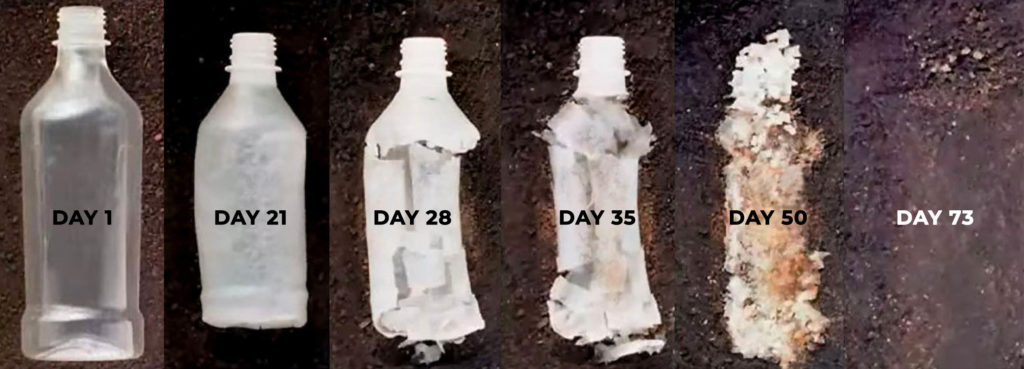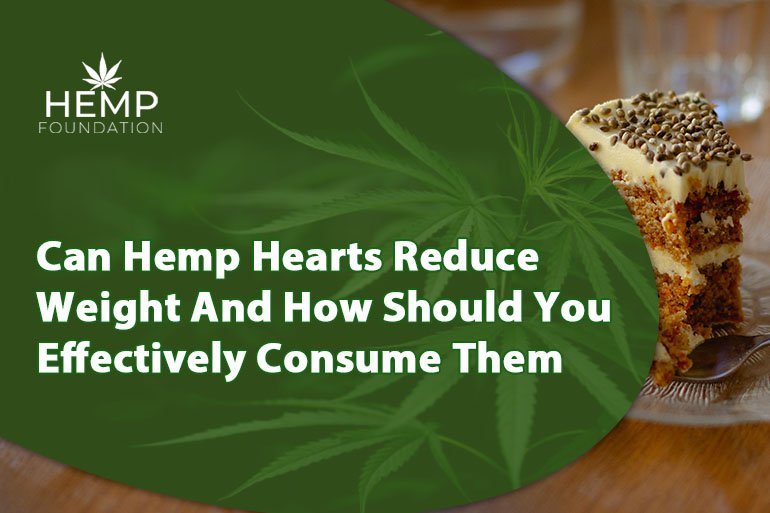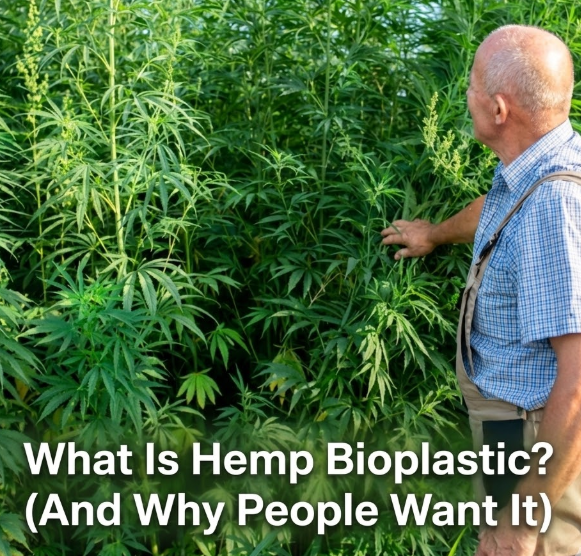Bottle Becomes ‘Soil’ In 90 Days Or Less – Big Retail Shocked By Hemp Packaging
This is the most important graphic of our times.

What you are seeing above is a bottle made from hemp bioplastic, go from being a bottle, to being soil, in 73 days.
That is why even big retailers like The Body Shop, Unilever, and Ikea are investing heavily in hemp-plastic packaging.
In fact, there is a race to become plastic-free.
The impact these sustainable packaging trends in retail will have on the market is huge. It will also cause smaller retailers to change their outlook on hemp-based alternatives. Let us discuss these impacts of retail hemp packaging in detail.
The environmental benefits of moving to retail hemp packaging
The Impact On Resources
Water, soil and land are three vital resources that we see vanishing before our very eyes.
Luckily, hemp can help.
Hemp-based packaging can decompose in as little as six months. This is nowhere compared to the hundreds of years required for conventional plastics. This reduces landfill waste and ocean pollution.
We should also note hemp requires much less water than many other crops. It actually needs only about 2,401 to 3,401 kg of water per kg of fiber—a 75% reduction compared to cotton. This efficiency helps conserve water resources.
Hemp is also known to absorb toxins from the soil.
Not only that, it also enriches it with nutrients like nitrogen, improving soil fertility and structure. This regenerative property promotes long-term agricultural sustainability.
The Impact On Carbon
Today, the majority of our plastic comes from petroleum.
Replacing petroleum-based plastics with hemp-based materials reduces industries’ reliance on fossil fuels. It can lower the greenhouse gases that are emitted by plastic production.
Another superpower of carbon is its carbon absorption capabilities.
An acre of industrial hemp can sequester between 8.9 to 12.3 metric tons of CO₂ per year. Some estimates suggest it can replace up to 10 tons of carbon per acre.
This makes hemp a powerful ally in combating climate change.
Hemp, a biodegradable packaging option for retail stores, can also help them offset their carbon footprint.
The economic benefits and market implications of moving to hemp packaging
Growth Projections and Potential
The retail hemp-based packaging market is expected to grow from USD 224 million in 2023 to USD 782 million by 2033. This indicates a compound annual growth rate (CAGR) of 13.3%. This shows us that the scope is there, but we still do have gaps to fill to reach our full potential.
The key areas where we can expect growth are Food & Beverage, and Retail Packaging. E-commerce and Textile packaging are also integrating hemp plastics.
In fact, in all these segments, retail hemp packaging has already been introduced. But this is at the start of the supply chain. It has also started to trickle down. This means hemp packaging for consumer goods will soon pick up speed.
Regulatory Support and Market Accessibility
Legalizing hemp cultivation has increased access to hemp materials for packaging. A key change for the better has been the 2018 Farm Bill in the U.S. This bill means hemp is no longer a controlled substance in the country.
It has also enabled large retailers to incorporate these sustainable options into their supply chains. Governments worldwide are implementing regulations to reduce plastic waste. This has accelerated the adoption of alternatives, including hemp-based packaging solutions.
Challenges and Infrastructure Needs
Despite the promising outlook, challenges remain. The main one is the lack of infrastructure for large-scale hemp processing. This could hinder widespread adoption among retailers. Investment in processing facilities and supply chain logistics will be crucial. This can help support the transition to hemp-based packaging.
The benefits to brands
Eco-Conscious Consumer Behavior Shifts
Three main consumer behavior patterns are observed here.
- Perception towards Hemp Plastics
A study found that consumers generally view hemp positively. It has an average rating of 4.85 out of 7 when asked about their opinions on hemp products. This indicates growing acceptance and interest in hemp as a sustainable alternative.
2. Willingness to buy
Consumers are more inclined to buy hemp for non-consumption purposes (average score of 4.72) than for consumption purposes (average score of 4.19). While enthusiasm for hemp products is evident, barriers persist. This is particularly seen in the food sector.
3. Age Factor
Younger consumers are more receptive to hemp products. But older demographics show skepticism. This generational divide highlights the importance of targeted marketing strategies. When done right, it can educate older consumers about hemp’s benefits.
Brand Image Enhancement
Brands adopting hemp-based packaging can enhance their image as responsible companies. Research shows that eco-conscious consumers are loyal to brands that prioritize sustainability. This boosts both customer loyalty and market share.
Using hemp-based materials allows brands to stand out by showcasing their commitment to sustainability and innovation. In a crowded marketplace, this differentiation appeals to consumers seeking ethical choices.
Corporate Social Responsibility
Transitioning to hemp-based packaging aligns with broader initiatives aimed at reducing environmental impact. Companies adopting sustainable practices enhance public perception and strengthen stakeholder trust.
Modern consumers expect brands to take responsibility for their environmental footprint. By adopting retail hemp packaging, companies not only meet these expectations. They can also contribute to global goals by reducing plastic waste and promoting renewable resources.
As is evident, big brands have started adopting hemp plastics. Growing customer demand is one of the key drivers of the increasing use of hemp plastics. If we want to completely replace traditional plastics, that would take a minimum of 15 years. But even the small steps are ones in the right direction.
Retail hemp packaging offers significant environmental benefits. This includes biodegradability, water efficiency, and carbon sequestration. Economically, the hemp market is projected to grow rapidly. This can provide opportunities for cost savings. This would help propel the rate of adoption of hemp plastics as well.
A very important encouragement factor is consumers’ positive perceptions of hemp products. With the younger generation leading the shift, we can expect the rate of adoption of hemp to improve.
Vishal Vivek
Vishal Vivek is the Founder and CEO of Ukhi, a pioneering bio-materials company dedicated to ending plastic pollution by converting agricultural waste into high-performance compostable polymers. With a background in sustainable entrepreneurship and over a decade of technology experience, he leads Ukhi’s vision to create scalable, planet-positive material solutions. Previously, Vishal founded the Hemp Foundation, where he empowered more than 1,000 farmers and advanced sustainable livelihood initiatives. His work has been recognized through awards such as the HDFC Parivartan Grant and featured in leading publications like Forbes and Entrepreneur. Times Group recognized him as a legendary entrepreneur and published his biography in “I Did IT- Vol 2” alongside social pioneers like Bindeshwar Pathak (Sulabh International) and Anshu Gupta (Goonj). Vishal has authored more than 200 articles on sustainability and hemp, reflecting his deep expertise and advocacy for regenerative solutions. His commitment to grassroots impact led him to live in the remote mountains of Uttarakhand, where he immersed himself in the lives of marginal farmers, understanding their challenges and co-creating economic opportunities through hemp-based initiatives. A deeply passionate innovator, Vishal often draws inspiration from seemingly impossible achievements: “If Elon Musk can make rockets reusable, or Dashrath Manjhi can carve a path through a mountain with rudimentary tools, why can’t we eliminate the demon of single-use plastic while uplifting struggling farmers? We will make it happen—whatever it takes.” Ukhi is proud to be supported by premier institutions including IIT Guwahati, NSRCEL-IIM Bangalore, Indian School of Business (Hyderabad), Indian Council of Agricultural Research (ICAR Pusa), and the Indian Institute of Packaging. Vishal is committed to demonstrating that business can be a powerful catalyst for global environmental and social good. Connect with Vishal Vivek
Related Posts
How can hemp make fashion sustainable?
The fashion industry is among the biggest polluters on the planet. The sector accounts for more than
Can hemp hearts reduce weight and how should you effectively consume them
Hemp, unfortunately, has been cast in a certain image. People, in general, associate it with marijua
What Is Hemp Bioplastic? (And Why People Want It)
Over the last few years, interest in hemp bioplastics has noticeably grown. People are becoming




